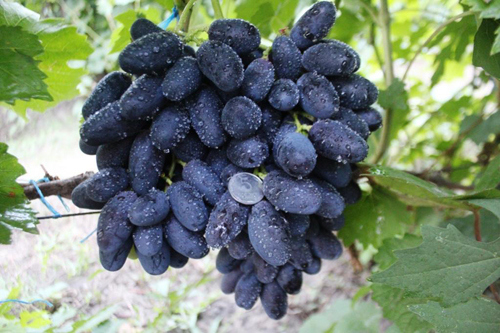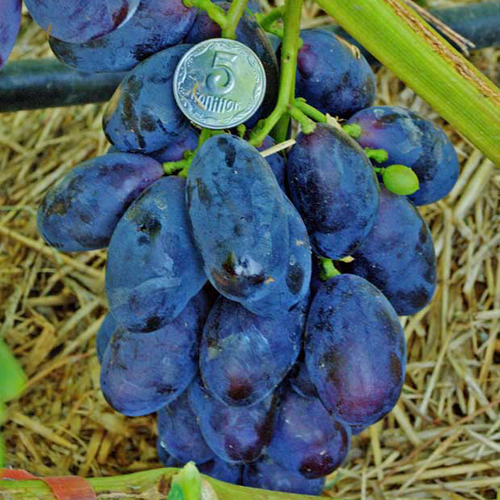Alvika grape variety
The hybrid form of table dark-colored grapes Alvik is one of the newest developments of the national breeder from the Zaporozhye region of Ukraine Viktor Kalugin. Viktor Mikhailovich's assets already include dozens of his own creations, many of which are of genuine interest from both amateurs and farmers. The main criteria on which the author focuses in his work are large-fruited and early ripening of its varieties. And even in this series, our heroine turned out to be the undisputed leader, producing the effect of a bomb exploding among winegrowers. Its giant berries simply amaze the imagination of those who have had a chance to contemplate them live, and this fact alone makes many fans sincerely dream of the appearance of this hybrid on their plots. In this regard, there is an exuberant demand for cuttings and seedlings, which is why the price for them sometimes reaches transcendental heights.

The phenomenal large-fruitedness of this grape is quite explainable by the fact that the breeder selected excellent varieties as parental forms Mascot and Great, the berries of which are themselves very massive. However, our heroine surpassed both her parents in this indicator by an order of magnitude, which attracted special attention in the professional environment. It is too early to talk about other advantages and disadvantages, since the young hybrid is still only undergoing variety testing with a small number of growers, and only on the basis of its results it will be possible to make an objective judgment about Alvik.
Agrobiological characteristics
Bushes from the first years after planting show high vigor. The crown is closed, almost white due to intense pubescence, which remains noticeable on young leaves and even on the axis of the shoot. Fully developed leaves are rather large, rounded or heart-shaped, with three or five lobes with a strong, delicate dissection between them. The color of the grape leaf blade is rich green with lighter veins, at the base of which anthocyanin tones can appear, the surface is reticulate-wrinkled, the profile is flat or slightly wavy. The upper lateral notches are deep, closed with an ovoid lumen or open lyre-shaped with a rounded bottom. The lower incisions are of medium depth, mostly open, with parallel sides and a pointed bottom. The petiole notch is open, lyre-shaped, with a sharp bottom. The petioles are shorter than the main vein of the leaf, green, sometimes with a reddish tint. The teeth along the edge of the Alvica leaf are of medium size, predominantly sawtooth, with convex edges and pointed apices. The flowers are bisexual, according to reviews, they are pollinated well, they do not crumble, and the formed berries practically do not peas. With the maturation of the one-year growth, the variety also does not have problems, the shoots ripen amicably and practically to the entire length.

The bunches are significant in size, and therefore their average weight is 600-900 grams, however, many overcome the kilogram mark, and the record holders reach two kilograms. In the first years of fruiting grapes, the mass of brushes will not reach the average, but as the accumulation of perennial wood, their size and weight will constantly increase. The shape of the bunches of the hybrid is broadly conical, and the structure is medium in density. The combs are long, herbaceous, but strong enough. The main decoration of the hybrid and the pride of its author are oblong grapes, magnificent in size and mass, which, on average, reach 41-43 mm in length and 25-27 mm in diameter. The weight of these giants can be up to 30 grams, but usually ranges from 20-25 grams. Alvica berries are colored blue-violet, and their surface is covered with a thick layer of protective pruin bloom. The high uniformity of large fruits in a bunch gives the brushes a very elegant and attractive appearance.Due to the not too dense arrangement in relation to each other, the berries do not wrinkle or deform. Their pulp is moderately dense, crispy, has a pleasant harmonious taste, but does not differ in its bright aroma. The data on the ratio of sugars and acids in the juice of berries are still contradictory, however, according to taste assessments, the fruits of this variety are unanimously assessed as sufficiently sweet. The skin of the grapes is quite strong, but chewing it is not too difficult. The number of seeds does not exceed 2-3 pieces, and they are weakly felt in a large volume of pulp. In general, the tasting characteristics of the hybrid are considered to be very high.
The harvest is great for fresh consumption. The excellent presentation of the grapes causes a very high demand for the hybrid from farmers planning to grow it for sale. It is quite obvious that bunches so catchy in appearance will not linger on the counter, and therefore the price for them can be set higher. Considering, moreover, that this grape ripens at an early date, one can predict a very high profitability for Alvika. There is no unambiguous information about the suitability of the crop for long-term storage and transportation over long distances, however, taking into account the strength of the skin, the density of the pulp and the good attachment of the berries to the bunch, it can be assumed that these indicators will be very decent. In the form of large berries processed into compotes, jams and marinades, they will also look very appetizing.

The duration of the growing season of the variety, starting from budding until the berries reach the conditions characteristic of removable ripeness, is 115-125 days. In the south of Russia and Ukraine, grapes are ready for harvesting by mid-August, and during this time the sum of active temperatures reaches 2400-2500 ° C. Such indicators characterize our heroine as an early-ripening variety, and allow her to be cultivated in regions of the middle zone of the country that are not traditional for viticulture. In the open field, without carrying out measures to artificially increase the SAT, it is capable of producing crops in all regions of the Russian Black Earth Region and even somewhat to the north. The author's declared ability of the vine to withstand low winter temperatures is increased (-23 ° C), but this parameter still needs to be checked, since the overwhelming majority of winegrowers cultivate a deficient form with careful shelter for the winter.
The yield of the Alvika bushes that have entered fruiting, according to the reviews of their owners, significantly exceeds the productivity of its parental forms of Talisman and Velika. The fruitfulness of shoots in plants is quite high, and even shoots that have developed from the lower buds of fruit shoots are productive. Given this circumstance, as well as the outstanding large-fruitedness of the hybrid, it can be assumed that its potential yield may be excessive and not respond to the vital energy of the bushes themselves. Possible overloading of grapes threatens with many troubles, in particular, weak growth of annual shoots, lengthening of the growing season, insufficient coloring of berries and a deterioration in their taste. In order to prevent this, the winegrower should take a closer look at his wards, detect signs of excessive stress in time, and avoid such omissions in the future. Annual errors in rationing the yield of a variety can provoke a strong weakening, and even death of plants.
Ripe bunches can continue to hang on the vine for a month without losing their attractiveness. At the same time, the berries do not lose moisture and do not grow raisins. On the contrary, with prolonged dampness or a sharp change in soil moisture, the problem of cracking of grapes may arise, and this must be taken into account, leaving the crop to ripen on the bushes. The pioneer winegrowers argue that no wasps were noticed to damage the fruit, and this evidence can be trusted, since a strong skin should reliably protect grapes from annoying insects.
Agrotechnical features
Being a very young hybrid form, Alvika needs a full-fledged variety testing, and therefore, for many nuances of its cultivation, the recommendations can only be the most general. At the same time, based on the already available reviews of the variety, with a high degree of confidence, we can characterize it as very promising and not requiring complex care.
When choosing a place for planting, it is necessary to be guided by the standard requirements for grapes in terms of sufficient provision of highly productive plants with heat, moisture, mineral nutrition and sunlight. First of all, it is important to give young bushes an impulse for rapid development, for which, on insufficiently fertile soils, planting pits are abundantly filled with mineral and organic fertilizers, and in arid regions they provide for mandatory watering. In the south, where warmth and sun for our early-maturing heroine will be guaranteed in abundance, the vineyard can be planted both on the plain and on the slopes of various exposures, except for the coldest ones. But closer to the northern border of the variety's distribution area, if there is a risk of incomplete ripening of the crop in cool seasons, plants are placed in the upper part of the southern slopes, or on flat areas on the sunny side of various buildings or dense hedges. This makes it possible to increase the SAT level by several hundred degrees compared to the open area.
Alvica cuttings root well, but it can grow on its own roots only in areas not infected with phylloxera root. In traditional regions of viticulture, where a malicious pest lives almost everywhere, reproduction is carried out by seedlings grafted onto phylloxera-resistant rootstocks. Vine bushes are placed freely enough to exclude future competition of vigorous plants for a place in the sun.
The variety is cultivated mainly with warming of the vines for the winter, for which the bushes are given stampless forms like a fan or an inclined cordon. However, where temperatures in the cold season do not fall below the -23 ° C indicated by the author, it is possible to advise, as an experiment, semi-covering standard formations with a reserve insulated vine in case of frost damage to the main part of the bush.
The pruning length of the plants that have entered fruiting is recommended to be medium (5-8 buds), and the total load - in accordance with the strength of the plants that they show with the existing level of agricultural technology. The main rule, universal for all large-fruited varieties, is that more than one bunch should not remain on each young shoot of grapes. Weak and sterile shoots are removed as usual when broken. Alvika's disease resistance is average, and, according to winegrowers, 3-4 fungicide treatments per season are enough to control the development of pathogens on it.








